Leads, leads, and more leads! Who doesn’t want more of that? Menaka Shroff, Head of Marketing at BetterWorks; Jen Grant, CMO of Looker; and JD Peterson, former CMO of Trello, discuss how to build a lead generation machine with Joe Chernov, VP of Marketing at InsightSquared and this session’s moderator. Menaka and Jen actually worked together at Box so they also share a little bit of their history and what they both learned there.
Getting leads doesn’t just chalk up to collecting names, emails and phone numbers. Are they the kinds of people who can benefit from the products and services your company offers? You want to close the right leads. It’s not about finding one particular campaign or ad that will bring in endless leads either. That one magic bullet doesn’t exist because there are so many elements that come into play. At a high level, demand gen is a lot easier if you concentrate on your NPS score, or in other words, making your customers really happy and successful.
And if you haven’t heard: SaaStr Annual will be back in 2018, bigger and better than ever! Join 10,000 fellow founders, investors and execs for 3 days of unparalleled networking and epic learnings from SaaS legends like Eric Yuan, Tomasz Tunguz, Chris O’Neill, and Mikkel Svane. If you don’t have tickets, lock in Early Bird pricing today and bring your team from just $799! (All ticket prices go up October 1st.) Get tickets here.
TRANSCRIPT
David Appel: My name is David Appel. I’m the Head of the Software and SaaS Vertical at Intacct. We’re very proud to be the Tactical Stage sponsors for today. We’ve got a fantastic session. This is going to be our fifth session of the day with a great title, “How to Actually Get More Leads.”
We’ve been prepping a little bit ahead of time. I’ll introduce the speakers in just a second. There’s a little bit of a sea change going on right now from what the last generation of marketing technology enabled with generating leads to this new flow of how do you start generating more account based marketing?
All four of our speakers are fantastic. They’ve got great backgrounds. Joe Chernov is the Chief Marketing Officer of InsightSquared. Long history in doing it.
Jen Grant is the Chief Marketing Officer of Looker. Menaka Shroff is the Chief Marketing Officer of BetterWorks. Jen and Menaka worked at Box. They got a lot of history and also a lot of familiarity. You’ll see as they present. JD Peterson help take Trello through this fantastic journey that they’ve just gone through into their acquisition by Atlassian.
What we hope is everyone walks away with a couple of ideas about how you can apply all this to making your own businesses grow. We got a blend of both high ACV and high velocity business models. Regardless of which you are, we think you’ll get something out of that. Without further ado, let me introduce the panel.
[applause]
JD Peterson: You want this side or that side?
Jen Grant: Yeah, use that side.
David: Joe has got a joke.
[laughter]
Joe Chernov: We have two Menakas.
Menaka Shroff: Oh, God.
Joe: Double the fun with yourself.
Menaka: Do you want me to sit with myself? That’s really awkward.
Joe: I’ll sit with you on either side.
[laughter]
Joe: All right. It’s really difficult to see, but I’ll give this a shot. How many folks feel like they have enough leads to run their business? All right, I don’t see any hands.
[laughter]
Joe: I have some really good news. These three panelists have personally guaranteed that when you return to your office on Friday, you will hit all of your lead quotas. Thanks to this very conversation.
[applause]
Joe: I’m going to ask the panelists just to introduce themselves, talk a little bit about the stage of the company that they work for, and to explain to the crowd what they think every entrepreneur should know about marketing but doesn’t. Menaka?
Menaka: My name is Menaka Shroff, as he mentioned already. I work for a company called BetterWorks. We’re a continuous performance management software to help with goal setting, OKRs, performance review, and peer reviews.
I would say it is Series B post, so not quite super early stage but just before the big scale hit phase. Before that, I was at Box for five years with Jen. I’ve seen that trajectory as well.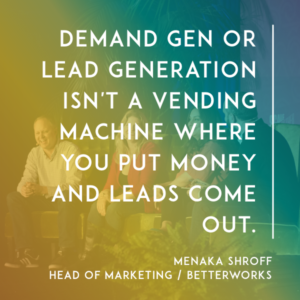
The biggest thing that I would say for founder CEOs is demand gen or lead generation isn’t a vending machine where you put money and leads come out.
[laughter]
Menaka: It doesn’t really work like that. It’s a bit of a factory where there’s different mechanics and specialties in demand gen that you need to work cohesively to do demand generation. I will talk a little bit more about that later in the panel as well.
I would also say I hear and I meet a lot of product, let’s see, CEOs, founders, and advise companies. Some product founders who are very proud of their product accomplishment will say things like, “We’ve grown to 100 customers and with no marketing,” and it’s like a proud sentiment.
While that’s cool, it’s astonishing, because imagine if you actually did put some marketing regard, discipline, or budget, or intelligence, you could have grown faster, bigger, probably more efficiently. I would say, think about it as a more holistic approach.
Don’t think the product will always be the shining armor that will lead the way in demand generation. The combination of a great product with a great marketing plus sales execution can be even 10X. Try to think a lot bigger than what your next four quarters are going to be.
Jen: I’m Jen Grant. I’m the CMO at Looker. Looker is a business intelligence platform. We actually solve the problem of either you’re waiting for the data or everybody has a different set of data and then you get in the room and everyone fights about whose data is right.
We actually are a data platform that brings all of the information from all your data sources together so that you can have a reliable conversation and actually make decisions. That’s Looker.
To go at the question, I actually meet with a lot of founders and CEOs. Inevitably, I usually come back to the same question of, how do I get more leads? More leads, more leads, more leads. The answer isn’t, “Oh, there’s that one magic campaign or that one ad that if only I found that ad.”
I’ve even had CFOs say, “Once you find that one campaign or that one ad, then we’ll put all our money into that one thing.” [laughs] That is not how it works, ever.
[laughter]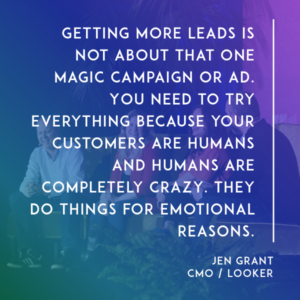
Jen: It’s all of the things. You actually have to try everything. We joke at Looker, we say like, “More, more, more. It’s always more, more, more.” While we’re a little bit joking, there’s a part of that that’s actually true. You need to try everything, because your customers are humans and humans are completely crazy. They do things for emotional reasons. They’re not logical.
They will not buy a product based on it is the logical choice for my business. They will buy a product based on some emotional connection. They liked your sales rep.
They read something that made them happy. You understand their pain. All of those things will bring you people to your business and it’s not the, “Oh, I had that one ad.” That would be my one thing.
JD: I like that. Hi, I’m JD and I’m unemployed.
[laughter]
JD: Some of you may have seen me on the corner this morning with, “Will work for a beer and equity sign.” That was me.
Recently, I ended a journey with Trello. Amazing company, amazing time with Trello. We just got acquired by Atlassian, and for a variety of reasons, I’m not continuing on that journey with them, but I wish them the best as they move forward, but amazing experience there.
Prior to that, a lot of my career was actually on the product side of the house. I fancy myself a little bit of product guy as well. That culminated, I was an early VP of Products at Marketo and then from there, made the full shift into a marketing career and I was a VP of Marketing at Zendesk for several years, from about 60 employees through our IPO, and then was with Trello for a little bit there as well.
The answer to the question? Founders and entrepreneurs, what do they need to know about marketing? Very timely for me since I’m talking to a lot of founders and CEOs right now about potential next adventures and that kind of thing.
I will first second the thing about the magic bullet, because I see that a lot in a lot of the founders and the folks that I’m talking to. They’re just like, “But where is that magic bullet?”
Waiting for that one answer that is going to solve everything, and certainly I agree, it doesn’t work that way.
The other thing I would say it’s that they need to know is that it takes a village. Marketing is a team sport, it’s a whole company sport. Maybe some of you saw the panel yesterday. A good friend of mine, Maria Pergolino, was up there from Apptus, also used to work at Marketo.
She was talking about one of the, which I loved, one of the main aspects of her job is getting all the other folks in the company, all the other departments to know that in everything they do, every interaction they have with a customer, every feature they put into the product, all these things are marketing.
The sum of every interaction someone has with your brand, that’s marketing. That’s the impression they have of you. I think that’s an important thing to always keep in mind.
Joe: You worked with Maria who is like…I can’t think of a person in the world that is better at generating leads than Maria. How do you generate a lead?
JD: How do you generate a lead? I guess that’s the topic here. How do you actually get more leads? My answer probably will be a little bit different than maybe what you would expect.
There’s certainly are all the tactics and we can get in all the different ways that you ultimately capture someone’s email address. As we were joking in the back there, it’s not just capturing a name and an email or a phone number.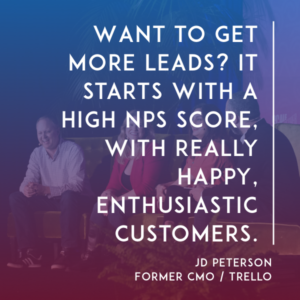
Otherwise, I’ll give you the phone book and I’ll be done. Mic drop on that. To me, you want to get more leads? To me, it starts with, get yourself a high NPS score.
It’s easier said than done but ultimately that’s what it comes back to. You’ve got to have a company, a product, a brand that people really identify with and resonate with and enjoy being around, and are going to promote.
In marketing, it’s often overlooked. Like NPS, that’s product’s problem or that’s support’s problem and certainly those things play into it in a massive, massive way.
I think marketing plays a lot of role into how people, their perception of the brand, it’s the stuff I was mentioning a minute ago, of all those interactions. You want to get more leads? I think it starts with customers who are going to be your best advocate.
In today’s world, it’s so easy for people to talk to their network, go read a review online, and get all this information. You want a lead that’s going to actually convert into something. I think it starts there. It starts with really happy, enthusiastic customers.
I also think it relates to the team you build. The reality is we’re going to tell you about some tactics, we’re going to talk about some channels.
You could walk around and stop us later, talk to other marketers and we’ll tell you about search engine marketing and that sort of thing.
As the guy from Veeva was talking about this morning too, I think that execution is what matters. Everybody has really got close to the same playbook of nowadays. You want the Maria Pergolino playbook, follow her on Twitter. She’s transparent, she tells you about it.
I think it’s about the team you build and how they execute is ultimately how you are going to get more leads.
Joe: Your answer assumes that the company has achieved product/market fit, they have customers, they have customers long enough to have NPS data. Menaka, if you were just starting a company now, you’re searching for product/market fit, it’s really early days, how do you think about getting your very first lead?
Menaka: When I joined BetterWorks, we were actually in stealth mode, and so the product wasn’t even out and we were generating leads.
Joe: What were you doing?
Menaka: I think the biggest thing that we did, and this was the brilliance of our leader, Kris Duggan, but one of the things we did was put out a content piece on goal setting and goal science. It was just a simple white paper where we put in the passion behind how we’re going to build our product. It was very simple, and that’s all.
The home page of the website was, basically, a gated asset landing page. That itself was enough for people to get early momentum. I think one of the things he did early on was hire two really strong sales reps, who understood the business and got that early traction, momentum.
I think the combination of having a really strong piece of asset, some degree of marketing through advertising, and having good team that’ll actually get in an early customer base, was a good enough persona for me to say, “OK, I see the buyer profile, now I understand how to think about growing leads,” so I think it starts with your audience.
One of the things that I’ll add to how you actually get more leads is…the mechanics are simple. Your levers are budget. You have your offers which is free sign up to content gated asset, to attending events, to free up/download, what have you, or a purchase on your site, and the channel where you’re going to advertise to get interests.
That’s actually the simple thing. The mastery comes in, how do you tune that effectively with the mix to support the velocities?
If you’re a highly transactional type business, then maybe the free offer with the right degree of assembly marketing, online digital, it works, but if you’re a mid market enterprise, then you might have to think about content assets, and get them to attend an event or a field marketing thing. It just depends on that audience, and then going from that.
Joe: I’ll ask the three of you this, but I’ll start with Jen. How do you think about attaching a number to lead volume? How do you attach a goal to your lead quota?
Jen: That’s a really good question. I almost would turn it around a little bit and say, what’s more important is understanding, back to where we started, what actually is a lead.
As a marketer, I could buy a ton of lists of names that some company has researched that, they work for this… these companies have these software that they use, and that might connect and I could buy all these lists.
Joe: Don’t just do that.
Jen: They never work, right?
[laughter]
Jen: They never work. I rarely found a list, if never, that actually would convert it because these people are just random names. What you really need to find are, as you start coming up with lead goals, is understanding what actually constitutes. Is it, they have a budget?
In our case, at Looker, we want to talk to the data analyst. We know that they will get us if we can talk to them. When we were at Box, it was the IT person. We know they’re the person that’s going to make this decision.
You have to define, “OK, if I’m going to get a data analyst, what size of company?” Some of my reps may not, in the early stage of a company, be able to talk to Fortune 500.
Certainly at Box, that was the case. In fact, we did in the early days. We got a couple of Fortune 500s on the phone and no, we could not sell them because we didn’t have the product for them. We did have a product for small business, or for a team, or for an individual.
It’s actually defining what is it that gets you, the person that if you just got the product in front of them, they’d go, “Oh my god, that’s exactly what we need.”
Once you run your marketing mix and you start scoring, “Oh, this is that lead and I’m getting it from these channels,” then you can sit back and go, “OK, given my budget, how many of these can I get?”
Joe: How do you do that at Looker? You’re a very aspirational organization, so for the people in the crowd, that’s like, “Someday, I wanna grow up to be just like Looker.” How does Looker do it? How do you identify what that goal is?
Jen: We actually look at the model, so it becomes more of a…We sit down with finance and we sit down with sales and we say, “OK, what are our revenue goals?” and then we actually back out of it that way. We’ll do it from bottom up as well, to make sure that at least…
Menaka: That it aligns.
Jen: [laughs] Are we aligned, did we…At Box, we were extremely like, “We’re gonna do some amazing million, trillion, billion,” and then we’d go, “Er, let’s do a bottom up and make sure that that’s reality,” because there are certain things that are always reality.
Your website will get a certain number of people coming to it, and as you get more news and as you get more ads out there, and as you get more awareness, that number will go up and up and up, but it rarely spikes. You’re rarely going to see a, phew, except for a few things like you have a funding announcement and your website will spike.
In the rare case, that some launch that you do somehow gets an amazing amount of press. We were in the Mary Meeker report, phew, that was great for us. There are certain things that spike, but you cannot depend on them happening. [laughs]
Menaka: Even if they spike…
JD: You get hacked.
[laughter]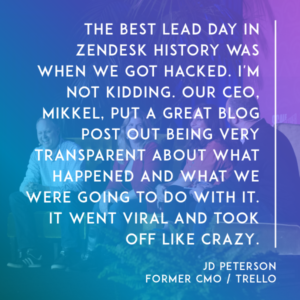
JD: The best lead day in Zendesk history was when we got hacked, I’m not kidding. Our CEO, Mikkel, put a great blog post out, being very transparent about what happened, what are we going to do with it, and that thing went viral and took off like crazy.
Menaka: Let’s not aspire for that, though.
JD: “They’re getting hacked, they must be important and big,” and everybody came to us.
Jen: Like, “What is this thing? Hardly talked, they dealt with that very well.”
JD: There’s your tip for the day. Go home…
[laughter]
Menaka: I was just going to say, the co founders and founders don’t aspire to get hacked.
Joe: Stage a hack.
Menaka: Yeah, stage a hack. Occupy hack.
Jen: It all goes back to the math, because if you look at the growth of your website, it’s only ever going to go at a certain rate.
When then you say, “Here are my revenue goals, here’s the organic traffic, and here’s my budget, and I know for this budget, I can do some SEM, I can do some whatever, content syndication, I’ve got all these channels, I’m only going to get X amount for the amount of budget and for the possible growth of my website.”
If I then take all conversion rates, so lead to meeting, meeting to demo or a trial, and trial to deal, how can my sales reps convert up into money? That’s where you end up getting your lead is you’ve got to run the numbers.
Of course, the craziest thing, which I’m sure you all have seen, is that you make that model, and then the nature of our business, [laughs] the nature of SaaS, the nature of growth, all of your inputs will change.
You have to be constantly…well, actually our ACVs going up and our sales reps just got better, and they’re converting at a higher rate, so maybe we don’t need as many leads to get to this revenue target. If we put more budget into it, we can raise our revenue target.
There’s all sorts of…the puzzle of the mathematics of the model for high growth businesses we’re all in are constantly changing. [laughs]
Joe: What if we had no historical data? JD, the next great SaaS company comes up to you and says, “I can’t believe you’re on the market. I’ve the greatest idea in this entire industry,” and you believe them and they say, “How many leads do I need to generate right now?”
It’s very early days. How do you think about that number then or do you think about that number then?
JD: I think the last part there is where I was going to go. Going back to some of the earlier questions, I think at that stage, I actually had this conversation with someone just like that this morning, I think it’s about finding those lighthouse customers or whatever you want to call them.
It’s finding those specific accounts that you know are the perfect fit for your product, can be successful with your product. It’s doing everything you can to aim your sights on those and land those, which then trickles back into my original answer of make them really happy and successful. They’re going to refer you to the next folks and the next folks, and that sort of thing.
In the early, early days, I would forget lead targets and revenue targets and that and I would say, “How do we go get the right kind of people to come by and try our product, and let’s do everything humanly possible to make them successful?”
Menaka: Another way you could do it is if you had sales reps, you want to make sure that the sales reps are busy and you want to ensure that there’s enough volume to get them to at least discover what the product market ideal fits as customers.
You want the sales reps growing, so ultimately you need that healthy growth on the sales side to ensure you’re hitting your revenue goal.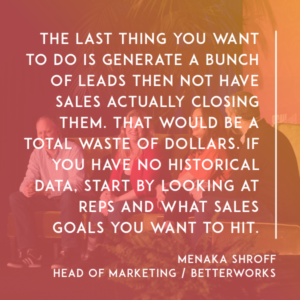
The last thing you want to do is generate a bunch of leads, then not have sales actually closing them, that would be a total waste of dollars. I would say start from the sales goal or start from the sales reps. Start from how many meetings per sales rep do we want, every quarter, every month, whatever is the right metric, and then start from something simple.
It’s less about having a fixed number and getting really tight about it. It’s about growing month over month. You want to make sure that you’re growing qualified opportunities, leads, in a good way, because I think that’s really an indication that we have a product market fit. If you’re not doing that systematically well, then there’s something else you got to go back and reflect.
Whether it’s product market fit or it’s your message, or the way you’re doing marketing.
Jen: I would actually add one of the things I saw when I came to Looker. I jumped in Looker at the post Series B where it was time for scale, but then I learned about how they had gotten to where they had gotten.
It was different from what I’d seen at Box. Box we focused on organic, website. How do we get people blogging? How do we get traffic to our site? How do we get free accounts that we can then call and say, “Hey, do you want to buy?”
In the case of Looker, what they did is they found a couple of just great sales reps who just picked up the phone. They had their BD guys out there getting a company and then saying, “Hey, do you know anyone else in this industry who would benefit from this product?” They had their VCs saying, “Who in your portfolio could we sell this to?”
They had their personal network they were going after, and they had these sales reps that would just get on the phone, do a demo, as many as you can. They really didn’t in the early days have marketing in the sense of having marketing people actually running marketing campaigns. It was fully sales focused.
Of course, what is interesting about that is when you get to that stage in the middle, where you’re ready for scale, then you have a whole set of reps that from a marketing perspective, you adore because they work hard. They know how to pick up the phone and call.
The flip side when you have a freemium situation as we did at Box, everything is easy. There are all these people coming, all these names.
The sales reps have this lovely world of like, “I’m just selling. This is so easy.” When you have to scale, it’s not easy anymore. It becomes culture shift of like, “Oh, wow. This is harder now,” instead of the reverse, where it has been so hard for the sales reps and the marketing person comes in. It’s like, “Oh, wow. This is easier than it was before,” which of course, is why I found it to be very lovely.
I actually think both ways are equally valid and equal directions that you can go when you’re at that early stage.
Menaka: Even the persona can be something really simple. For example, when we started BetterWorks, OKRs, software was what we sold. We knew that Google had done OKRs. They started at 40, they went to 40,000.
John Doerr was on our board, he is a big OKR champion. We knew that a quick persona target would be people from Google who left and joined other companies to take leadership roles.
That’s a good fixed amount of people to focus on. That’s a good momentum. You understand more about the person and you can say, “OK, well the profile is someone who is a business leader and is trying to align people cross functionally and they need software for that.” You can grow from something very simple and a little bit more basic, and then start building on top of that.
Joe: Want to change it a little bit from leads to all the other stuff in marketing. In some ways, the success of the marketing automation vendors changed the conversation in marketing and brand became a dirty word. It’s not so dirty these days.
[laughter]
Joe: There’s the pink Pendo dinosaur outside and we’ve got an outdoor ad campaign running all around your hotels. Brand is starting to make a comeback. JD, how do you think about a balance between brand– like immeasurable marketing or is it even immeasurable, and this funnel marketing that’s been thrust upon us by your former employer.
[laughter]
JD: Yeah, totally. I think brand is critical and I think that especially in the world we live in today, where it is so noisy and there’s so many companies competing for the same space and on the same channels. You’ve got to supplement that telling your story and humanizing who you are as a company and putting that out to the world.
How do I think about it? When it comes to spending dollars, I definitely think it’s important to look at your marketing as a portfolio approach.
What really matters is the totals. I’m going to spend across all these different things, I’m going to spend $X in aggregate and I’m going to generate this much business on the other end. That’s what really truly matters.
As long as that ratio stays good, you can balance within the portfolio just like you do your financial assets. It’s better to have a broader playing field.
Even something like a search ad, you’re going to be way more effective. Someone is more likely to click that search ad if they also saw you at the SaaStr Conference or somewhere else. These things all play very much together, some of them honestly.
There is a challenging conversation with CEOs who much to your point have been taught by the Marketos, and those types in the world that it’s, “Dollar in, this is what I get back,” that kind of a thing.
I think you just have to have those raw, honest conversations. There are just certain things that if they represent who you are and they’re just things you believe in and they’re going to be helpful to your customers and your end audience, just do them and you just stay dedicated to doing them.
Menaka: I’ll just chime in. I’ll say that if you read The Economist, the print mag, the person who is writing the article, you talk with them, their social media, their website, it all sounds like the same person did it all. It’s very consistent.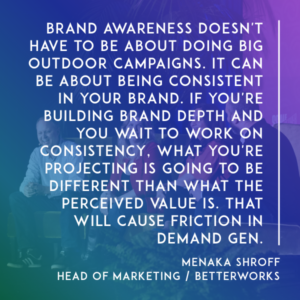
Brand doesn’t have to be something we’ll spend dollars to do big outdoor house campaigns. It can be being consistent about your brand. In The Economist’s case, it all sounds very colonial. That’s their style.
I would say, for your company, try to figure out what your brand voice is because if you’re building brand depth, if you don’t work on it and then the more you wait to work on that, what you’re projecting is going to be different than what the perceived value is.
That will cause a friction in the demand gen. That’s literally going to do that. You have to spend a lot more a head to fix that. I would say invest in, at least get that tone, the messaging, the things, attributes down first.
Grow from there and do things like events which are a great example of brand, but they also help with multi touch marketing.
Jen: I would say, you’ve got to be open to a little bit of religion, and I’ve said this to people. You’ve got to be open to a little bit of religion. It is very difficult and I’m coming from a data driven company like no other.
There are certain things you can’t measure and then every once in awhile, you get this little glimmer of this little chance to measure it. We actually did at the beginning of this year. We had a couple of weeks.
We knew the sales reps had tons of meetings, we were in good shape, so we shifted our ads spend away from one size of business to another. All of a sudden, we saw, as we expected, the leads from that size of business went down. We also saw is that our organic leads went down, which was this wonderful moment. Not everybody understood why we were so excited, but we were excited.
What it meant is that the spend that we were doing in the advertising that we shifted was actually giving us brand awareness. People were coming to the website which means that the money that we were spending on that particular channel was actually working way harder than it showed in our data.
It’s that moment of a marketer dream of like, “I told you that’s how it works.”
JD: There’s still a touch to that.
Menaka: Not the leads going down part.
JD: It works that way.
Menaka: Just the correlation part.
[laughter]
JD: I see the tide turning there.
Menaka: With all the leads going up.
Jen: The leads up good.
JD: How one lever impacts the others? That’s why you got to look at it as a whole portfolio. You can’t just isolate on one thing and how it’s performing because you sometimes won’t know how it’s helping one or the other channels.
The other thing I’ll just add to is that when it comes to some of the immeasurable stuff or brand things, offline things, definitely and all the stuff we’re talking about, it all really comes back to you.
You got to know your audience though and your target. If you have a very niche audience that you’re trying to sell to, don’t go put a billboard on 101. Unless it’s for recruiting or whatever, but those impressions aren’t your target market.
Of only of a small sliver of that are your target markets. Even if you’re doing big brand things and whatever, still make sure it’s somewhere where your audience is there and they pay attention to it. You’re targeting that still as best you can.
Menaka: You could do the clever things like PFL is a software that we use where…it’s for ABM, which is account based marketing where we’ll send a couple of emails and then the third action is actually a postcard that we send to this account that’s important for our sales team.
The fifth touch is a call. I think you can be clever in how you do some of these things.
If you wanted to experiment, and there are a lot of technologies to do that, but yeah, I agree with the rest of the point.
Joe: We’ve got one minute left. You mentioned ABM. My joke is how do you know two B2B marketers are talking about ABM? Their lips are moving?
[laughter]
Joe: It’s literally the only topic people seem to talk about. Jen, if it’s an entrepreneur in the audience, early stage company and they hear all the stuff about content and inbound, now they’re hearing this rise of account based marketing. They seem mutually exclusive.
What advice do you give? How do they know which model makes more sense for them?
Jen: That’s a really good question. One of the things I say is ABM, those always these marketing fads, “ABM is it the next one?” It’s not, it’s not a fad. It’s a great, great strategy.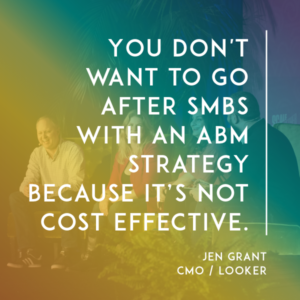
However, it’s a very enterprise strategy. You do not want to go after SMBs with an ABM strategy. That’s not cost effective. At the same time, it may not be in an early stage strategy. Perhaps, with companies like Menaka’s where you’re really going after a larger company, that might make sense.
In the case of the Zendesk, Box, Looker, Trello where you’re SMB, and you’ll eventually get to enterprise. It’s not what you need to do right away.
JD: Exactly. ACV are for those sorts of things dictated, you got to be pretty high up to make the investment in it.
Jen: Yeah, but it is exciting. We’re testing it.
Menaka: I think most people do hybrid ABMs. There’s some degree of account based marketing that’s helping the sales team where the SDR and outbound team is building contacts, and then, marketing is like, “All right, you do that, I’m going to try get you leads so we can both collectively have a functioning org.” This just depends on your business.
Joe: Well thank you all. I know we’re up against the clock.
[applause]
Joe: Thank you.
JD: Thanks.
Jen: Thanks.

